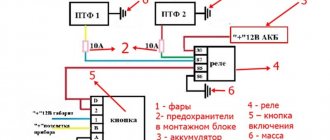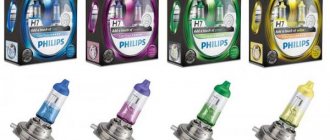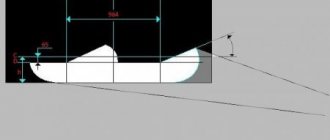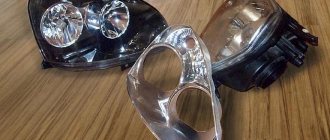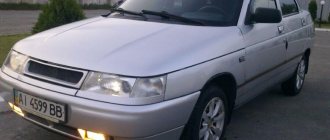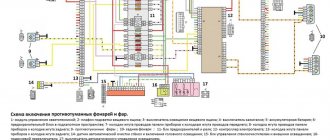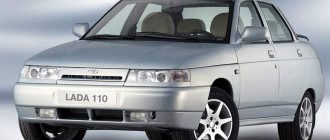For those interested in the development of modern automotive technologies, laser headlights, the operating principle of which is based on phosphor glow, are no longer a curiosity. Moreover, the so-called adaptive optics based on this development has already become known. How the laser headlights of the future work, on what principle they work, how much they cost, and why the consumer pays that kind of money - is briefly and clearly described in this material.
Characteristics
Laser headlights are the next step in development in automotive lighting technology, which will soon replace almost completely the existing classic types of headlights (xenon or halogen). This type of lighting is significantly different from solar and all artificial sources. Despite the illumination range of 500-600 meters, it is safe for the eyes and does not interfere with other road users, since the fluorescent material creates a white glow that is as close in color to daylight as possible, which means that it is not capable of dazzling or interfering with traffic .
The use of such headlights allows you to save energy by 2-3 times, when compared with the same diode ones; laser ones are compact (size about 10 microns), thanks to which headlights on cars began to be made much smaller, while maintaining efficiency.
Laser headlights are safe for the eyes
Principle of operation
This device is based on the operation of a conventional fog lamp. The main task of such a headlight is that precipitation does not fall on it, because the optics are in an awkward position - below the fog line.
The operating principle of laser headlights is exactly the same: they can be said to take into account the location of the frost. The light lies directly on the road with a red stripe, signaling for other drivers. Despite the fact that the light is LEDs, thanks to which the laser operates, the headlights are not a source of illumination, but an element of energy supply.
No matter what the headlight is, inside it the atoms of the active substance consume some energy, converting it into photons. For example, an incandescent light bulb device has a tungsten filament that emits light when heated. This principle has been modified and transformed. Laser flashlights can provide power that is several times higher than the power of basic xenon lamps (video author: Techno Drive).
Design and principle of operation of laser headlights
It is necessary to begin with the fact that such headlights are most correctly called laser-phosphor, and not just laser. The design of this type is not complicated: it consists of several laser diodes, which, in turn, illuminate the phosphor, which converts the received energy into light radiation, due to which a powerful beam is formed, which is 1000 times more intense than even a diode beam. Also, the resulting beam is coherent and monochrome, which means it has a constant wavelength and phase difference. Its power is 170 lumens.
The beam is initially blue, and to achieve brightness it must pass through a phosphor coating, which scatters the laser beam, producing powerful light.
Therefore, in this case, it is important to understand that the laser itself does not illuminate the road, but only produces the necessary energy.
The head laser light works in conjunction with a computer, which, using special sensors, monitors the appearance of oncoming cars and pedestrians and allows them to avoid blinding them. The Dynamic Light Spot system detects obstacles while driving, drawing the driver's attention to them using more intense light, which helps to prepare in advance for the necessary maneuvers and actions.
The design of this type of headlights is not complicated
Headlights of the future: which are cooler, laser or diode?
For the matrix LED optics of the Mercedes-Benz CLS you need to pay an additional 112 thousand rubles. Do they really shine so well that they have to shell out that kind of money? In 2011, “Auto Mail.Ru”, at the invitation of Philips, visited Aachen, Germany, where the company’s engineers spoke about the evolution of automotive light (for details, see our material “Headlights of the Future: Xenon, Halogen or LEDs?”). And now - a new invitation. What will the Germans show now? Night, a suburb of Barcelona, journalists are placing... pieces of carbide inside a metal barrel. For what?! It's simple: the barrel is part of a car of the now forgotten Reyrol brand from 1909, and thus we light the headlights. Let's rock - in the truest sense of the word.
This photo clearly shows the evolution of automotive lighting. Cars (bottom photo from left to right) by type of optics: acetylene torches, simple electric lamps, halogen lamps (two cars in a row), Philips X-tremeVision halogen lamps, matrix LED headlights
First you need to open the tap of the acetylene generator (the same barrel) so that water begins to drip onto the calcium carbide. As a result of the interaction of carbide and water, acetylene is formed, which through tubes reaches directly to the ceramic burner hidden inside the headlight. We stand and wait - this process is not quick. Is it time? We open the headlight glass, strike a match - at first a barely visible light appears, which soon goes out. We wait again and bring the match again. As it flares up, a small tongue of flame quickly becomes a fairly bright source of light. Go! How bright is the path illuminated by an acetylene torch? They say that successful samples, equipped with parabolic reflectors, could pierce the darkness for three hundred meters. But either the Reyrol optics are not very perfect, or contemporaries embellished the reality, but driving a car from the beginning of the last century on night roads is simply unsafe. You can't see anything! If a strong wind comes and the light inside the headlight simply blows out - get up and re-ignite it. And every four hours, fill the generator with carbide and clean the burner from carbon deposits...
While the acetylene torches on the 1909 Reyrol (top left) provide little illumination of the road, the electric lamps on the 1934 Packard (top right) contribute much more to safe driving. The 1964 SEAT 800 (bottom left) already has effective asymmetrical optics based on halogens, and the 1968 Daimler DS420 headlights generally shine very well, reminiscent of modern ones in light quality
With electric light, of course, it’s easier. In 1912, when tungsten filaments appeared instead of carbon filaments (the latter were afraid of shaking), acetylene lamps immediately gave way to incandescent lamps. The 1934 Packard luxury sedan has exactly these, and with two filaments: for high and low beam separately. (By that time, a diffuser had already been invented - a headlight glass covered with lenses that deflects the light of the lamp). But the driver is blind again! Packard's "long-range" is much weaker than the "close" of any modern car. And only when you switch to a Daimler DS420 from the late sixties do you begin to feel confident. Glory to halogens! By the way, it’s too early to consign such headlights to the dustbin of history - in the future, halogen lamps will continue to be installed on mass-produced cars, since they can shine at the “xenon” level. As an example, Philips engineers showed X-tremeVision lamps, which shine 130% brighter and emit 20% whiter light (3700 K), almost catching up with xenon (4300 K), as well as the Philips WhiteVision model, emitting 60% more light, moreover, “xenon” light (4300 K).
According to experts, by the end of the 2030s, approximately half of the cars produced will retain halogens as a simple and cheap light source! It's no surprise that engineers continue to improve halogen lamps by improving filament performance, increasing discharge gas pressure, and improving the quality of coating and quartz glass.
But the most advanced car light today is matrix LED headlights. And this is a real masterpiece of engineering art! For which you need to pay 112 thousand rubles - this is the cost of the Multibeam option for the Mercedes-Benz CLS. What are they asking for that kind of money? Each headlight has sections: daytime running lights, static low beam, mid-range active low beam, high beam, and side lighting. All this equipment is controlled by a computer that receives data from the camera, light sensors and GPS navigation. Such headlights consume three times less energy than xenon ones, and their color temperature is higher: 5000 K instead of 4300 K, so the light is whiter, reminiscent of natural daylight (6500 K), which makes the eyes much less tired. As such, there is no longer a strict division into near, far and “anti-fog” modes, since the electronics themselves regulate the shape of the light beam. Here's how it works. Everything is clear with daytime running lights - their task is to indicate the car during the day. The static low beam section illuminates the road directly in front of the car, acting as a “fog light”...
This is how the Mercedes-Benz CLS LED headlight works: 1. Daytime running lights and turn signal. This section also serves as a “welcome light” that illuminates the owner’s way from the car and back. 2. Active low beam. This section, consisting of four LEDs, can be rotated at an angle of up to 12º, and also act as a “middle light” (between “low” and “high”). 3. Active high beam. Each of the 24 LEDs can be turned on, off, and also change brightness, and each LED has 255 stages of brightness. 4. Static low beam. Three sections of eight LEDs (2+2+4) illuminate the road directly in front of the car and the side of the road, acting as fog lights. 5. Side light. Two LEDs turn on only before turns and side junctions, and sections of either one or both headlights can be turned on
What about the low beam? It is especially good when cornering, which the system recognizes using a stereo camera that scans road markings and data from navigation. Before a turn, the side lighting sections are connected, and the light beam itself is deflected (the corresponding group of diodes is rotated at an angle of up to 12º), moreover, shortly before the moment the driver begins to turn the steering wheel. To illuminate the exit from a bend in advance, the headlights also return to the straight-line position in advance. At roundabouts, “smart optics” generally try to illuminate the entire circle. But the most interesting thing is the “distant” one. You don’t have to turn it off at all outside the city! The beam formed by the beams of two dozen LEDs of each headlight constantly changes its shape in order to illuminate the road as much as possible, but not blind other drivers: when an oncoming or passing car appears ahead, the system will instantly dim those LED elements that could interfere with others. The system is smart enough to simultaneously track up to eight cars. The “range” is also impressive - the LED “long range” shines up to 485 meters.
When turning, the LED matrix headlights seem to “look” into the bend. At the same time, the side of the road and part of the oncoming lane are also illuminated, but the passing car is “in the shadow.” At roundabouts (bottom left), the side beam reflectors of both headlights work to expand the illuminated area and see not only the entrance to the roundabout, but also cars leaving from the left and “from behind the circle”. The entire road is brightly lit (bottom right), but the area where the oncoming car is moving remains dark as the system turns individual LEDs on, off, or changes the brightness
By the way, Audi optics are also equipped with an infrared night vision system, and therefore the headlights can illuminate pedestrians: if the night vision system notices a person 250 meters in front of the car, the headlights, without blinding them, will blink at the “living obstacle” and “draw” an illuminated path in the right direction retreat. Otherwise, the Audi Matrix LED system is similar to the Mercedes Multibeam, although the Mercedes matrix headlights change the light beam more smoothly than the Audi LEDs, since for each individual diode there are 255 brightness levels versus 64. Alas, Philips laser optics are not available showed: engineers are still working on this area. But why? After all, lasers are the future! Or not? “Automotive laser optics does not exist,” Matthias Hagedorn, a lecturer on modern lighting systems, stunned the audience. How so if the Audi R8 LMX and BMW i8 got laser headlights? But Hagedorn continued calmly: “In existing designs, the beams of several lasers only hit a phosphor plate, a phosphor, which emits a beam of white light. Therefore, it is correct to call such technology laser-phosphor!”
It’s hard to believe, but the LED headlights of the flagship S-Class are simpler than the optics of the CLS model: the headlights of the large Mercedes-Benz also cast a shadow on an oncoming (or passing) car, but according to a different principle - using a special flap that moves, accompanying the approaching car
Thus, the laser is only a source of energy, but not a source of light. And if now there are “near” and “far”, then laser-phosphor optics is “ultra-long”: such light turns on at speeds above 60 km/h and shines at 500-600 meters. Impressive? Honestly, for 15 thousand euros (according to our information, this is how much “lasers” cost) I would like more, since the same half a kilometer is illuminated by matrix LED headlights, and the new generation of LED optics will be longer-range and more functional - in the high beam section will have not 24, but 84 diodes. Therefore, the conclusions are as follows. The future is LED headlights. However, if engineers teach “lasers” to shine further, then these headlights will become the prerogative of ultra-fast supercars. Alas, due to its high cost, perfect matrix LED optics will remain a feature of only premium cars for some time. But mass-produced cars will receive LEDs, albeit static ones, since Philips (every third car on the planet is equipped with their optics) has already created affordable lighting solutions. Goodbye xenon and halogen?
The Audi R8 LMX was produced in a limited edition of 99 units. It is for the LMX version that you need to pay an additional 35 thousand euros: for this money the owner will receive a more powerful engine (570 hp versus 550 hp), carbon fiber body parts and, of course, unique laser optics. Four 1.6 W laser diodes illuminate the phosphor, the light from which, after passing through a system of reflectors, falls on the road. The laser light has a range of up to 600 m, while the LED high beam (regular, not matrix) illuminates the road at 300 m, and the low beam at 150 m
Finally, let’s answer a popular question: is it worth overpaying for matrix LEDs? A night test drive showed that active headlights are a great thing. Especially for our roads, where you need to peer intensely into the distance, looking for potholes, night pedestrians and broken down trucks without lights or warning triangles. Although ordinary, inactive diodes also shine beautifully...
Source
Advantages and disadvantages
Advantages:
- Compact design;
- Saving energy consumption (consumes almost 30% less than classical sources);
- High spatial coherence;
- Large (about 600 meters) and clear lighting range, thanks to the use of high technology;
- The possibility of glare is eliminated, since the direction of light is focused to one point;
- Automatic shutdown of diodes if a person or any living creature enters the lighting area;
- High intensity and power of lighting;
- Interaction with pedestrians;
- Indication of vehicle dimensions when driving in cramped conditions;
- Limiting the direction of the light beam thanks to microcontrollers.
Such headlights are economical in energy consumption
Flaws:
- High price. Today, this type is the most expensive automotive light source.
- Fragility of the structure.
Exclusive in everything
Optional laser headlights are offered for the BMW i8. It was on this model that they debuted in 2013. How is this possible if sales of headlights are just beginning? It's simple: in June 2013, laser headlights were exclusively installed on the first eight production copies of the German sports car, handed over to the lucky owners during a special ceremony in Munich. In technical terms, the solution is not much different from what we saw on the Audi R8, and BMW has the same supplier - Osram. On the i8, laser high-beam headlights are also installed not instead of traditional ones, but in addition to them, and are turned on only when the appropriate conditions exist. Well, we give you complete freedom in choosing expressions that are appropriate in relation to the option price of -9750 euros (in Europe).
Which ones are better to choose?
Today, laser headlights are installed only on premium cars and are not sold as a separate spare part, the main reason for this is the high cost, as well as the very expensive cost of replacement or repair.
Therefore, of course, those who can afford them in the future will not regret the purchase even once, because this will be the most optimal solution.
In the meantime, when choosing light for your car, it is recommended to choose diode headlights that have the best technical characteristics and an affordable price that fully corresponds to the quality.
As for xenon and halogen ones, these types have long outlived their usefulness and have many disadvantages that will result in many problems and financial costs for the driver.
Headlights of the near future: xenon, LEDs or laser
We now have a unique situation: there are cars on the market with four different headlight technologies. Let's find out which lamps are more promising and efficient - traditional, xenon, diode or laser.
In our last publication , we traced the long path of automotive lighting from kerosene stoves and bright carbide lamps to the familiar halogen lamps with diffusers.
But already in the 90s it became clear where to move next. And it was possible to move towards reducing energy costs and increasing brightness. After all, even lensed optics with conventional incandescent lamps no longer met modern requirements. And then gas-discharge light sources, long used in stationary lighting, came forward to fight the darkness.
Xenon: powerful, complex and expensive
Among the people, the name “xenon” is firmly attached to such headlights, although, strange as it may sound, they have nothing to do with xenon arc-discharge lamps. The enormous power and good spectrum given the poor efficiency of arc lamps turned out to be unnecessary, and what we used to call “xenon” is actually a metal halide lamp, inside of which a mixture of gases burns. It sometimes uses xenon gas as one of the ingredients, but often does without it.
The efficiency of this solution is more than sufficient - 80-100 lumens per watt of power, and the spectrum of emitted light turned out to be one of the best and most natural. For comparison: a regular halogen provides 13-15 lumens per watt, a gas-filled one - about 10, and a regular vacuum - about 8.
No other types of gas-discharge lamps could compete with them; even sodium lamps with an output of up to 200 lumens per watt did not pass strict selection due to the limited light spectrum. Their yellow light might not be reflected from some surfaces, and such objects would appear dark, and road safety is no joke.
There were two main difficulties in introducing gas-discharge lamps. Firstly, in order to ignite an arc inside the bulb, a voltage of about 25–50 thousand volts is required. Secondly, the entire volume of gas glows inside the flask, and this light must be very clearly directed in the right direction.
The second problem was perfectly solved by floodlight (lensed) optics, which was already discussed above. Well, the development of electronics has successfully dealt with the first problem. In 1991, the Hella company, which, by the way, started with the production of acetylene lamps, began selling the first sets of serial “xenon” for cars. This was a very expensive option for the BMW 7 Series E32.
Unlike conventional lamps, which are powered directly from the on-board power supply, xenon is powered through the so-called ballast or ignition unit.
As we have already said, when starting a gas discharge, a voltage pulse of 25 thousand volts or higher is needed, and after starting it is necessary to accurately withstand the current. Simply holding the voltage is useless - the lamp changes its resistance greatly as it warms up. So the ignition unit is a very complex and expensive part of the lamp; it is responsible both for its quick “ignition” and for its durability (when the current fluctuates, the electrodes inside the bulb burn out, and the lamp must be replaced).
As we've already said, HID (i.e. "xenon") headlights are very efficient and produce 80-100 lumens per watt. With a standard 35-watt power consumption, this lamp produces a lot of light. In addition, it heats up very little and does not have a fragile filament, which means its service life is longer and it is not afraid of vibrations.
The highest efficiency values apply to sources of very “cold” light with a light temperature above 5,500 Kelvin - this is a characteristic bluish glow. Lamps with a light temperature of 3,500 or 2,700 Kelvin that is more comfortable for the eye have lower efficiency, but there is still a gap between them and conventional incandescent lamps in efficiency and luminous flux power.
The downside of all these advantages is the high cost of equipment, which manufacturers have not yet managed to “win.” For example, an original ignition unit for a Volvo S80 II will cost 14-17 thousand, and for a Volkswagen Passat B6 - 17-18 thousand. Moreover, cheaper analogues do not always exist.
Don’t forget about the mandatory hydraulic headlight level adjustment, which automatically changes the “angle of attack” of the headlights depending on the tilt of the body, so as not to blind oncoming motorists when driving over bumps. And also about the headlight washers, without which xenon cannot be used, since strong rays of “gas-discharge” light are incorrectly refracted through dirt and shine in different directions. All this prevents the technology from becoming widespread. Cheap cars still use regular halogens.
Source
Mercedes also chose the matrix
IN 2010, the second-generation Mercedes CLS became the first car in the world to have only LEDs in the lights and headlights. After a recent restyling, the Stuttgart sedan acquired the Active Multibeam Led option - the same matrix headlights as the Audi ones, and they work on the same principle. The headlights are controlled separately, allowing precise contouring of illuminated and unlit areas in front of the car. The LEDs adjust the size of dark spots very quickly and accurately, while the left and right headlights operate independently of each other. Every second, electronic units calculate the optimal configuration of the light spot a hundred times. The system receives initial information from a camera located at the top of the windshield. As a rule, the Active Multibeam LED system is offered as an option. The exception is AMG modifications, which are standardly equipped with matrix headlights.
Automotive lighting develops in strictly established directions that rarely change. Today, LED optics are of particular interest to most drivers. It has a lot of advantages that do not allow alternative solutions to approach this segment. And yet, technological developments do not stand still; a completely different concept of light delivery is gradually gaining popularity. These are laser headlights that have introduced fundamentally new qualities to the organization of optical support for a modern car.
Manufacturers
There are two categories of laser headlight manufacturers. On the one hand, such technologies are quite naturally mastered directly by car manufacturers. The most successful developments in the segment are demonstrated by Audi and BMW. True, laser optics still rarely appears in mass models - such equipment is more often acquired as an optional solution. And on the other hand, laser headlights are produced by advanced developers of LED technology. We can note the companies Philips, Osram and Hella, which occupy leading positions in the field of designing the latest. What is especially interesting is that in both categories, companies occupy highly specialized niches, promoting unique technological solutions.


